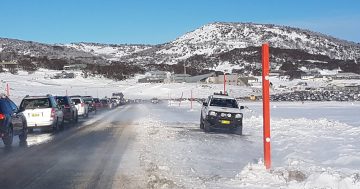
A day ski pass at Thredbo ranges from $189 and $209. Photo: Thredbo Resort.
Halfway through the 2024 snow season and it’s clearer than ever that skiing is a rich person’s sport.
The Jindabyne Chamber of Commerce has revealed the rising cost of ski passes has led to lower visitor numbers across all three major resorts in the Snowy Mountains, with some skiers opting to go overseas to places like Japan for not much more.
And there’s little chance this will improve if predictions of shorter snow seasons come true.
Wait, so how much does a ski pass cost?
An Australian dad has gone viral on social media for revealing how the price of ski passes at Perisher has changed in the past 20 years.
Michael Atkinson, one of the contestants on the extreme survival TV series Alone Australia last year, revealed that in 1990, a lift pass at Perisher was $46. This year, you’ll be slugged $249.
@outbackmike Snow sports Skiing Snowboarding Cost of living Cost of living crisis #snowboarding #snowsports #skiing #costofliving #costoflivingcrisis #skiresort @Perisher
“And it’s not inflation because I plugged it into an RBA inflation calculator and it should today cost $107 – chuck on GST because that came in later, and it should be $118,” he said in a video shared to Instagram, where he is known as @outback_mike.
“Inflation adjusted, the lift ticket should cost $118. It costs more than double that. Absolutely nuts.”
Perisher is considered the ‘premium’ resort, but the others aren’t much different.
A regular day ski pass for Selwyn Snow Resort costs $119 for an adult when purchased onsite, while Thredbo’s prices range between $189 and $209, depending on the day.
What effect is this having?
Jindabyne Chamber of Commerce Olivier Kapetanakos says Mr Atkinson’s observations are “absolutely” accurate.
“Skiing is becoming an elitist sport.”
Mr Kapetanakos grew up in Sydney but learnt to ski at Selwyn, once considered the more budget-friendly “feeder resort”. He started taking his four kids there about 15 years ago, and then Perisher 10 years ago as their skill grew.
“Prices have jumped significantly,” he says.
“You’ll go bankrupt pretty quickly at Perisher with a family.”

Rich people things. Photo: Alyson Lamb, Perisher Ski Resort.
On the international scene, he says the Snowy Mountains resorts are among the most expensive places in the world for skiing, which causes some people, particularly families, to seek their thrills elsewhere.
“If you’ve got school-age kids, like a family of five, it’s probably cheaper to go overseas.”
The prices have increased to the point where even though visitor numbers are lower, businesses in the area haven’t really taken a hit.
“Fewer people are paying more, basically, so it’s staying about the same.”
So, what does it cost to go overseas?
Catch a Murray’s bus to Sydney, and as of today, return flights from Sydney to Tokyo cost between $1300 and $1600.
According to Snow Japan, a day’s ski pass typically costs between 4000 to 5500 yen (that’s 38 to 52 dollarydoos). So you could enjoy five days skiing in Japan for the same money as one day in the Snowys, albeit with the addition of the airfare.
There are also ski tours available by companies like Japan Ski Tours for about $3000, which includes transfers to four different ski resorts, seven nights’ accommodation and 14 meals.
Will prices drop?
Mr Kapetanakos says pent-up demand during COVID resulted in higher prices that haven’t really come down. And based on a recent report by Protect Our Winters Australia (POW) and the Australian National University (ANU), he doesn’t expect them to improve.
This report expects some resorts to close their doors for good in the coming decades as climate change shrinks the snow season.
It predicts the average ski season across all resorts in Australia will be 28 days shorter by 2050 under the best, low-emissions scenario, and as many as 55 days shorter with no change to emissions.
This would effectively cram the Snowy Mountains’ current 12-week season into eight weeks.
“With the snow season potentially getting shorter, I don’t see prices reducing,” Mr Kapetanakos says.
“Prices will have to go up to ensure a similar turnover for businesses and investors.”
More unpredictable snowfalls will mean the resorts will have to fire up the snow-making machines more often, too.
“And with the cost of power today, to run 190 guns like they have in Perisher costs a pretty penny.”
It’s not all doom and gloom, though
This year’s season began late, and accommodation providers were left with few bookings until the very end of June. So far, so average, but Mr Kapetanakos says unless there’s a big dump within the next two to three weeks, September will most likely be a write-off for skiing.
“I’ve always said to people, come down in September because spring skiing is pretty good, and you have a lot more blue-sky days, which is kinder on the kids, but this year, I’m not sure.”
He adds: “The Snowy Mountains are unfortunately penalised for having ‘snowy’ in their name, but we’re also a great destination for summertime.”




















